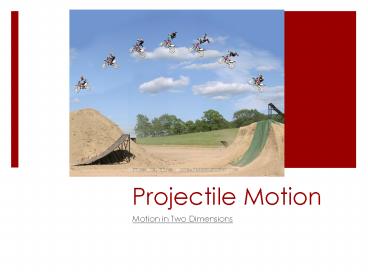Projectile Motion - PowerPoint PPT Presentation
Title:
Projectile Motion
Description:
Projectile Motion Motion in Two Dimensions ... - an object dropped from rest is a projectile - an object thrown straight upward is a projectile ... – PowerPoint PPT presentation
Number of Views:376
Avg rating:3.0/5.0
Title: Projectile Motion
1
Projectile Motion
- Motion in Two Dimensions
2
A Question to Begin
- At the instant a horizontally pointed cannon ball
is fired, a cannonball held at the cannons side
is released and drops to the ground. Which
cannonball strikes the ground first, the one
fired from the cannon or the one dropped?
3
What is a Projectile?
- Any object that continues in motion by its own
inertia and is influenced only by the downward
force of gravity (and air resistance) - - an object dropped from rest is a projectile
- - an object thrown straight upward is a
projectile - - an object thrown upward at an angle to the
horizontal
4
The path that the projectile follows is a
parabola
- the path is called its trajectory
5
Horizontal Motion
- If there is no force acting on an object, then
it will continue moving at a constant speed in
the same direction. - - there will be no change in its velocity
- - distance will increase the same amount with
each second
6
Free Fall Revisited
- An object in free fall is only acted on by
gravity - - Acceleration due to gravity is 9.8 m/s2
- distance covered increases with each second
7
Projectile Motion Combines Vertical Motion and
Horizontal Motion
- The vertical motion of a projectile is not
affected by its horizontal motion - -meaning The vertical motion of a projectile
is identical to an object in free fall - The horizontal motion of a projectile is not
affected by its vertical motion - - meaning the projectile will travel the same
horizontal distance as it would if it were simply
rolling on a flat surface in the absence of
friction
8
Projectile Motion Combines Horizontal Motion and
Vertical Motion
The vertical and horizontal motion of a
projectile are independent of each other
9
Horizontal Path Without Gravity
Vertical Path
10
(No Transcript)
11
Projectile Motion
- Projectiles follow a parabolic trajectory
- Horizontal component along trajectory remains
unchanged. - Acceleration only occurs in the vertical component
12
(No Transcript)
13
Projectile Motion and Complementary Angles
- Different launch angles result in different
horizontal distances traveled by the projectile - Same range is obtained from two different
launching angles when the angles add up to 90. - Object launched at an angle of 60? has the same
range as if it were thrown at an angle of 30?.
- What launch angle would have the same range as a
projectile - launched at 20o?
14
Projectile Calculations
For Projectiles Launched horizontally
Horizontal Distance d v(t)
Horizontal Velocity vf vi at
Vertical Distance d vit ½ gt2
Vertical Velocity Vf Vi gt
15
Review
- What is the path of a projectile called?
- Trajectory
16
Review
- Is projectile motion one dimensional?
- No, it is 2 dimensional-
- vertical and horizontal
17
Review
- What force (s) is acting on the projectile?
- Gravity only
18
Review
- Which direction, horizontal or vertical has
acceleration? - Which direction, horizontal or vertical has
constant speed?
- Vertical
- Horizontal
19
Review
- Two identical balls roll off the edge of a table.
One leaves the table travelling twice the speed
of the other. Which ball hits the floor first?
- Both hit the ground at the same time. The
difference in horizontal velocity does not affect
the vertical time.
20
Review
- At the instant a horizontally pointed cannon ball
is fired, a cannonball held at the cannons side
is released and drops to the ground. Which
cannonball strikes the ground first, the one
fired from the cannon or the one dropped? - They hit at the exact same time
21
Draw vector arrows representing
the vx and vy velocity components during the
course of the motion. The length of the arrows
should represent the magnitude of the velocity
components.
22
Draw vector arrows representing
the vx and vy velocity components during the
course of the motion.































